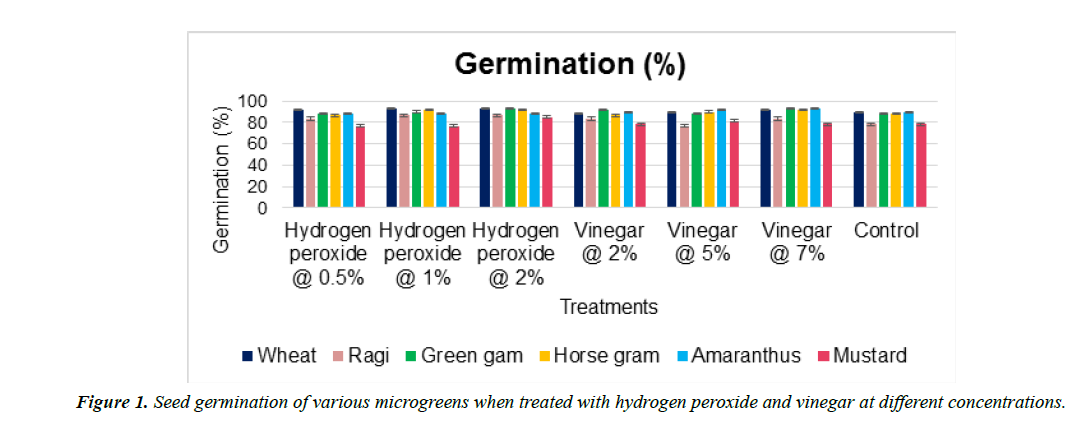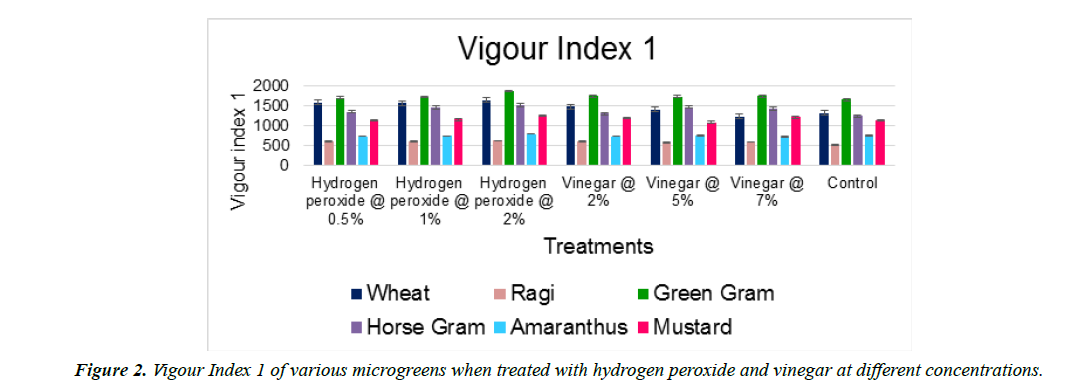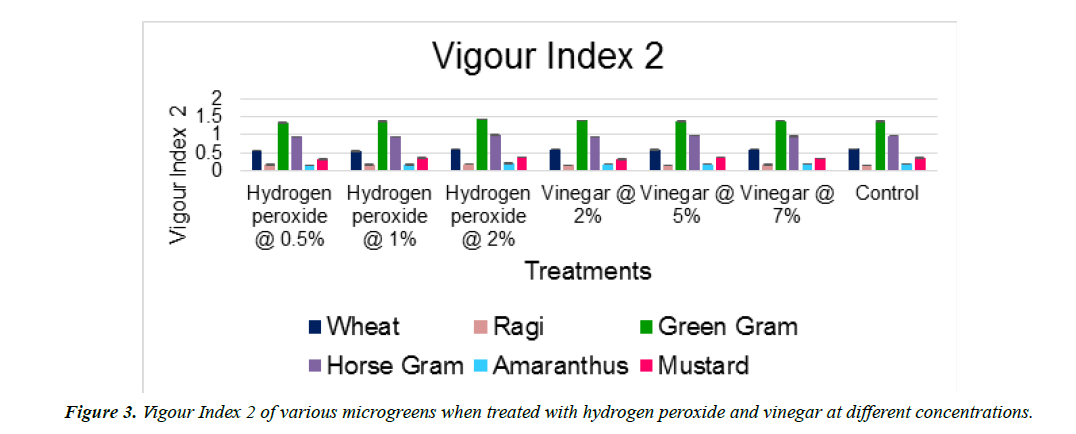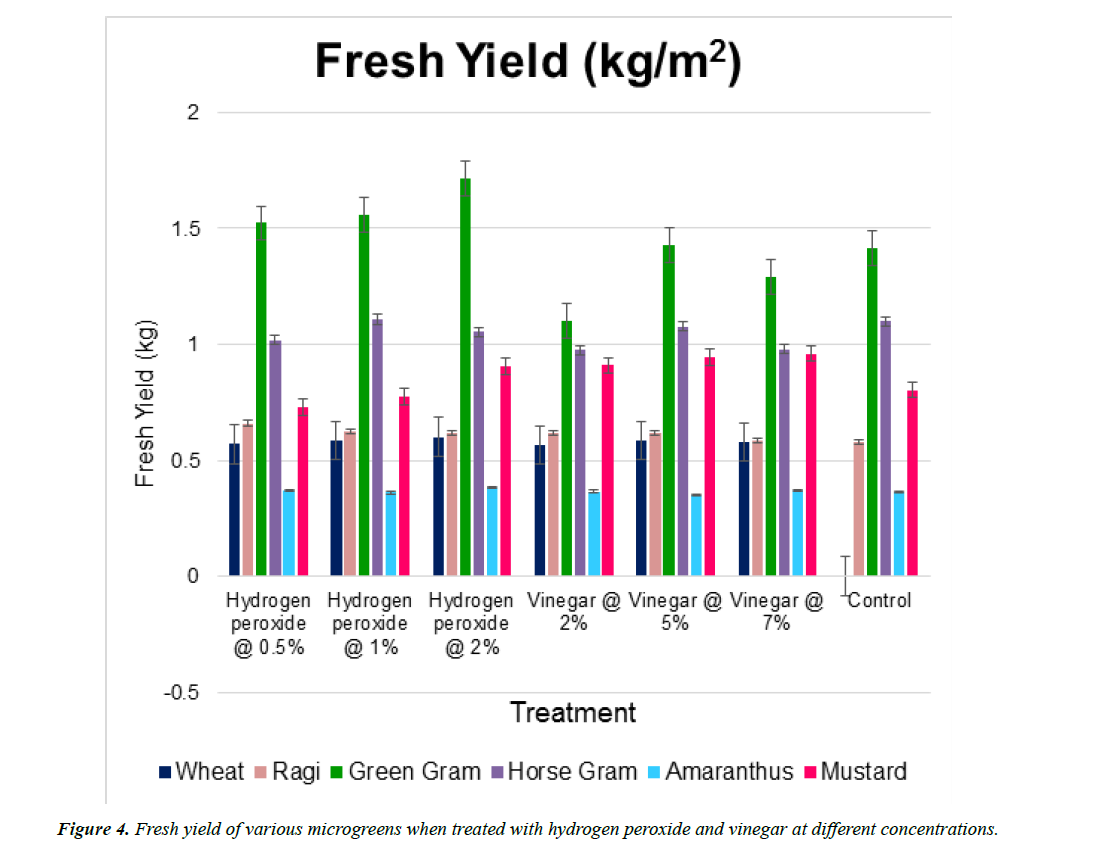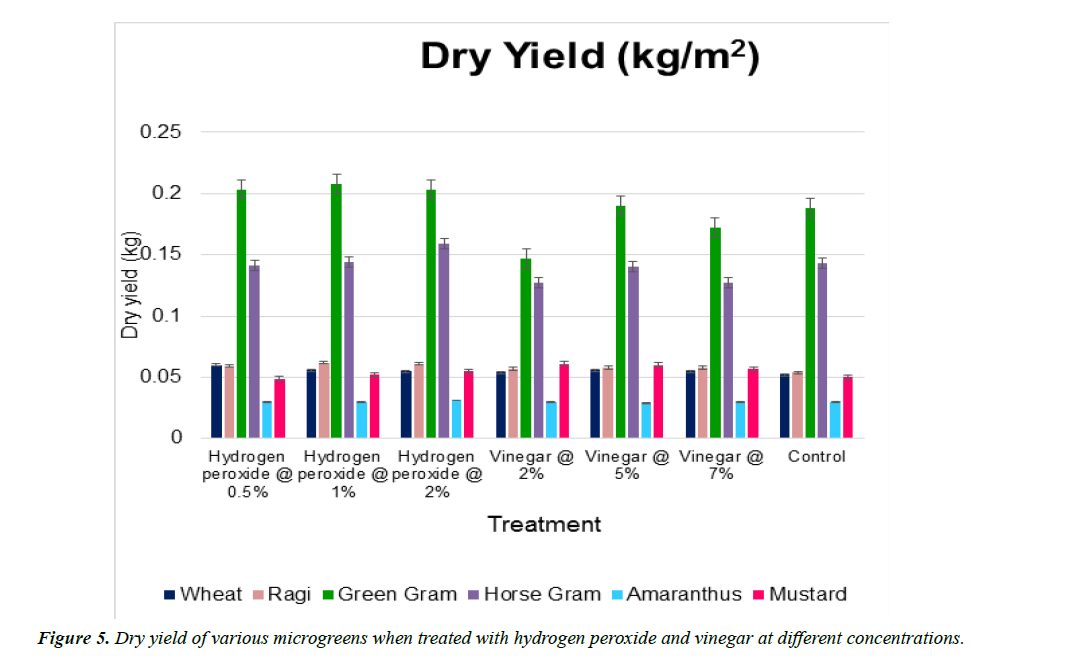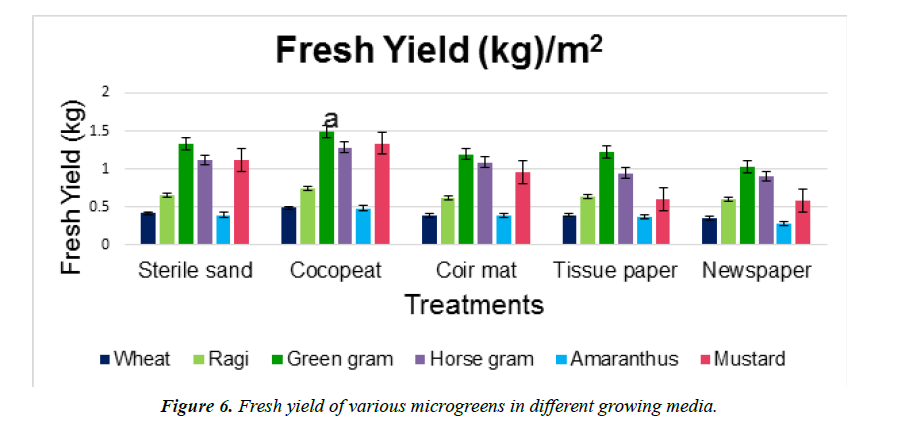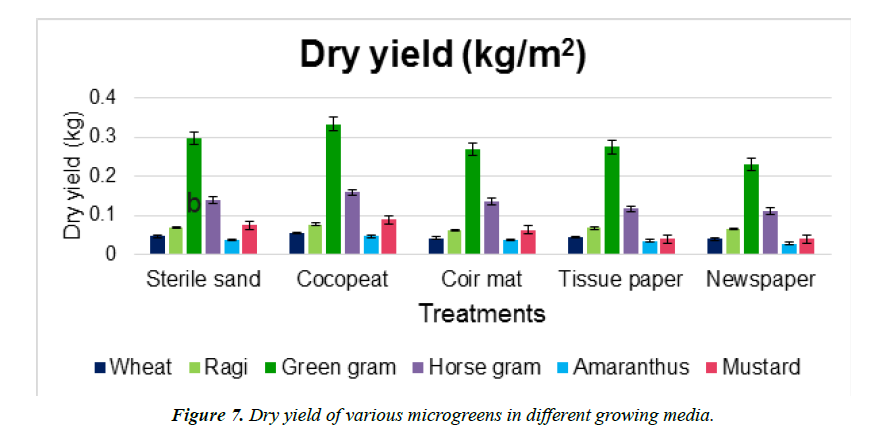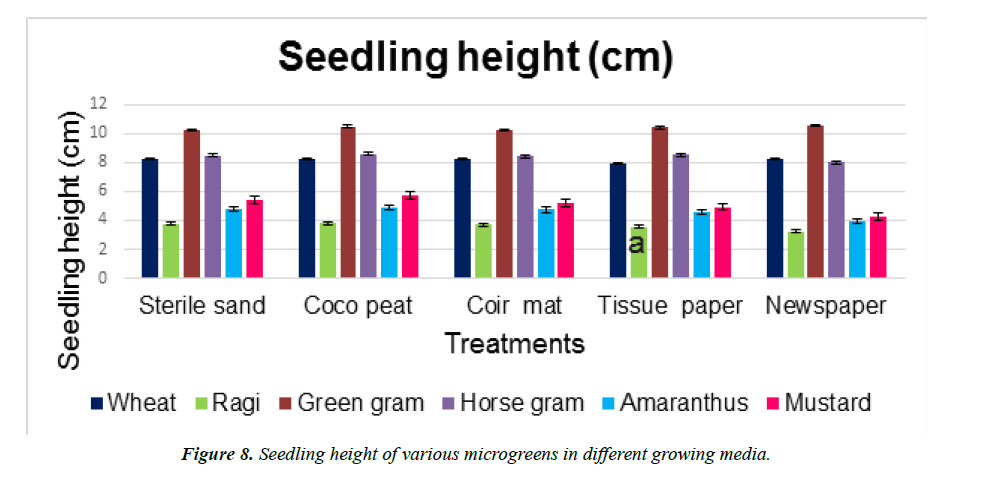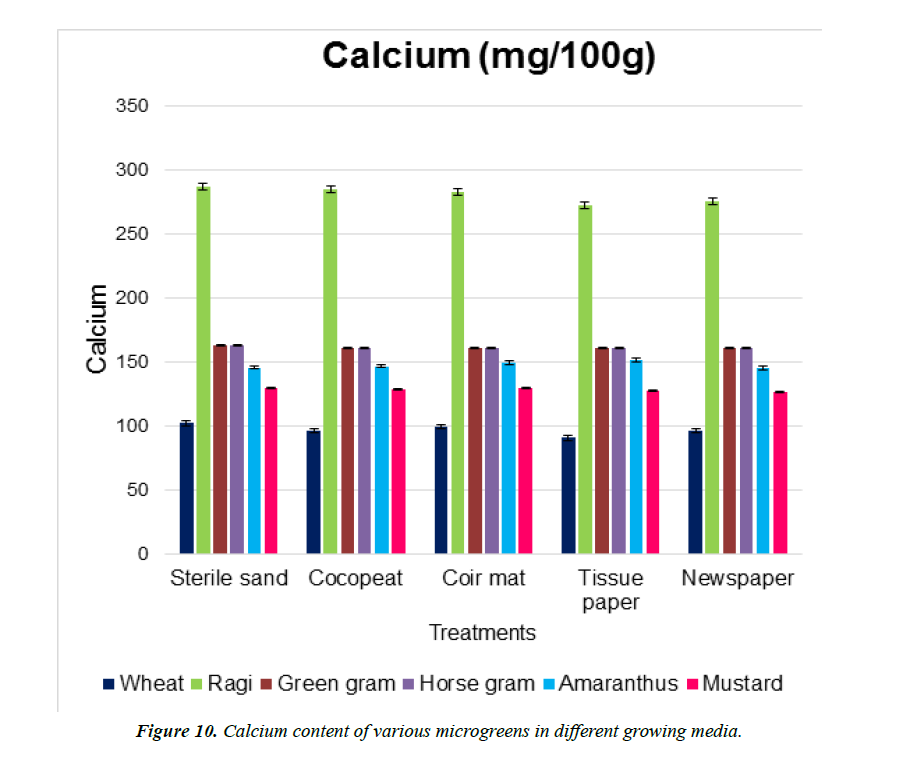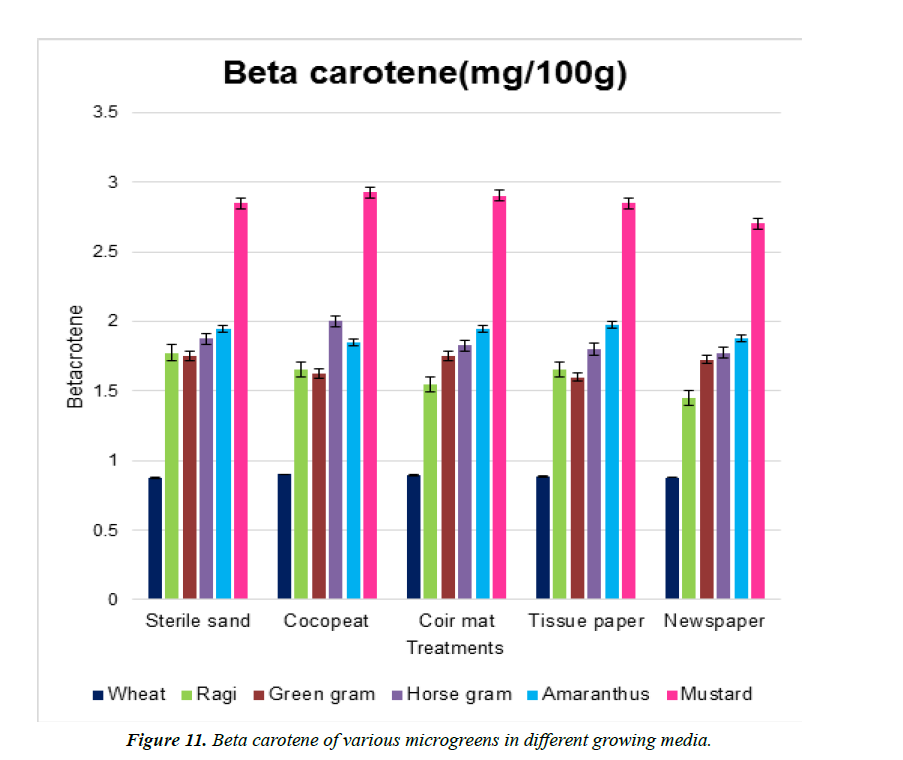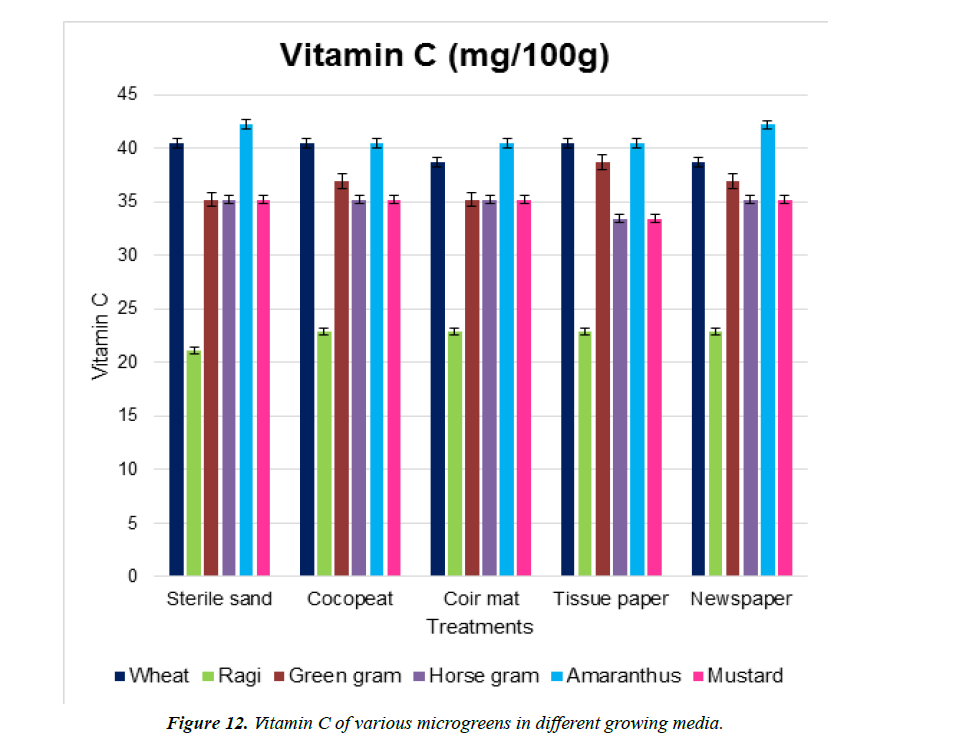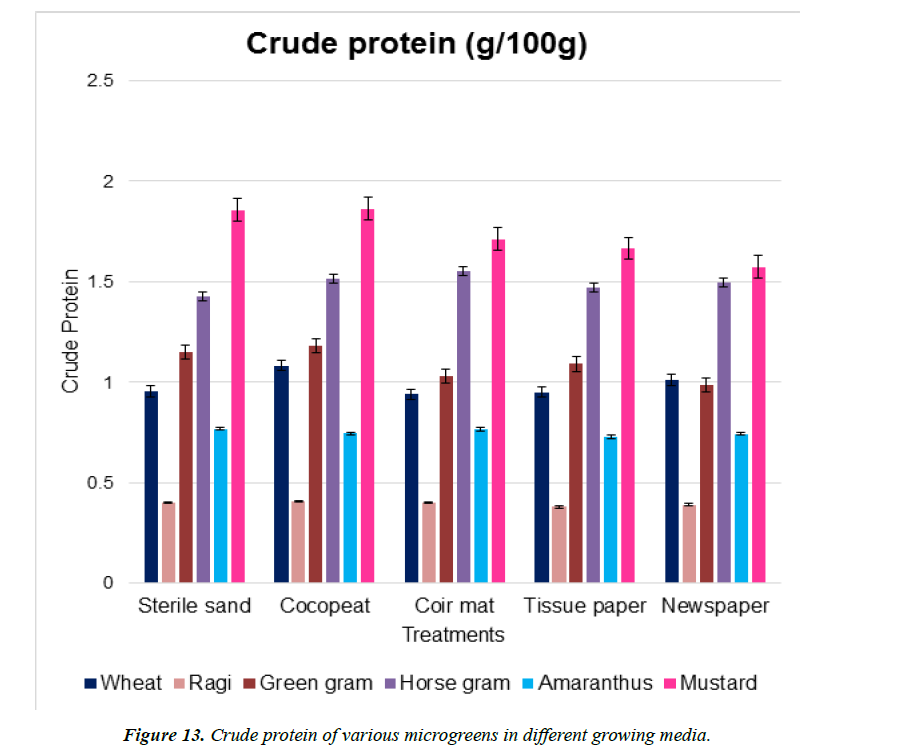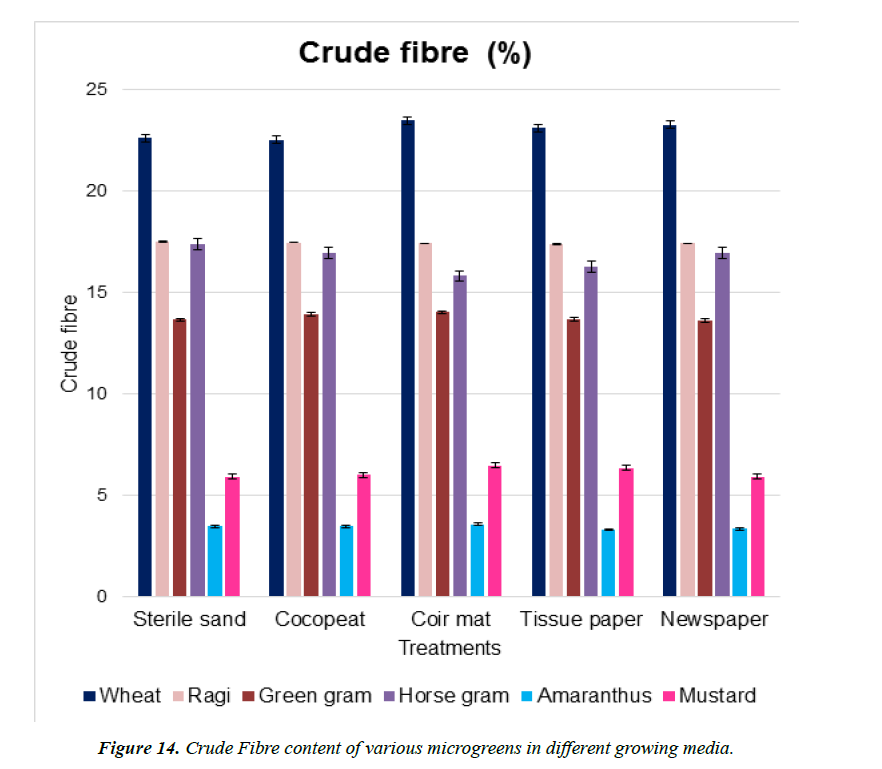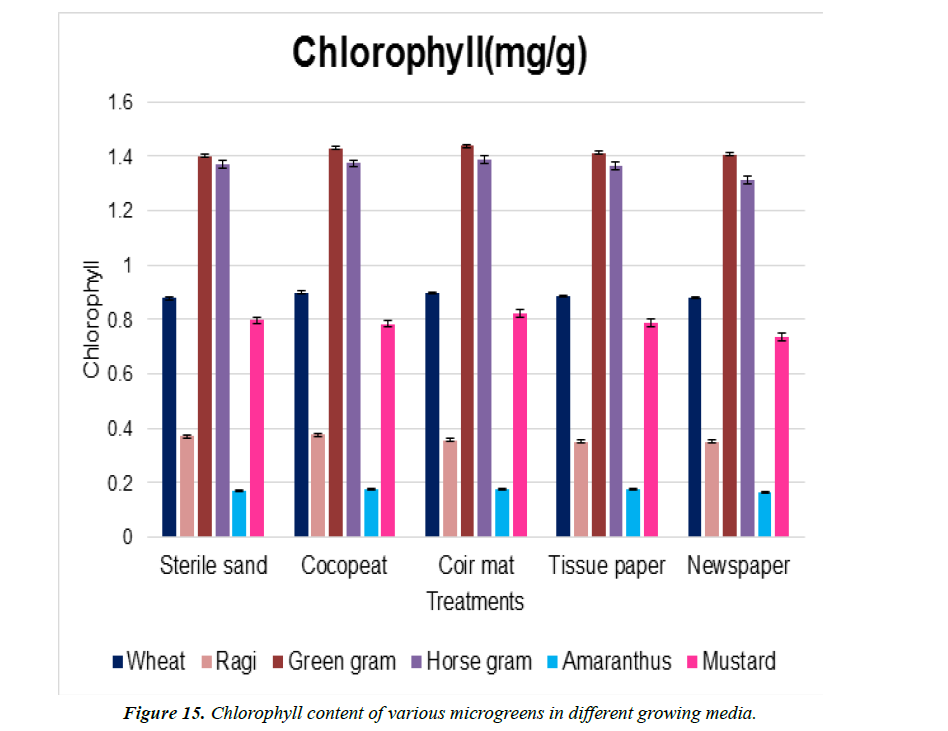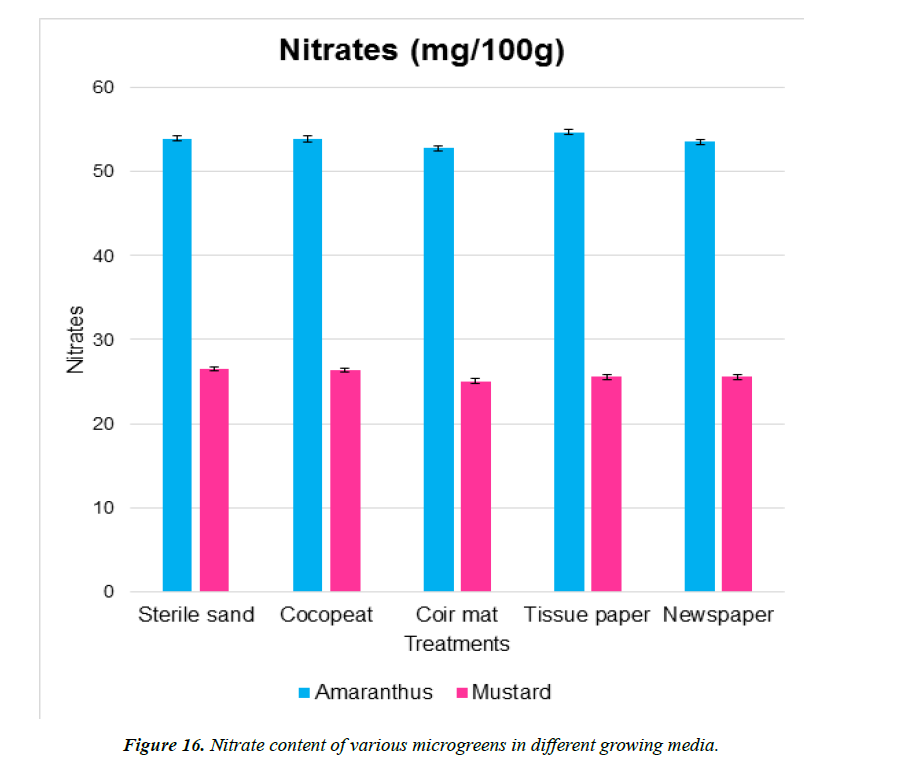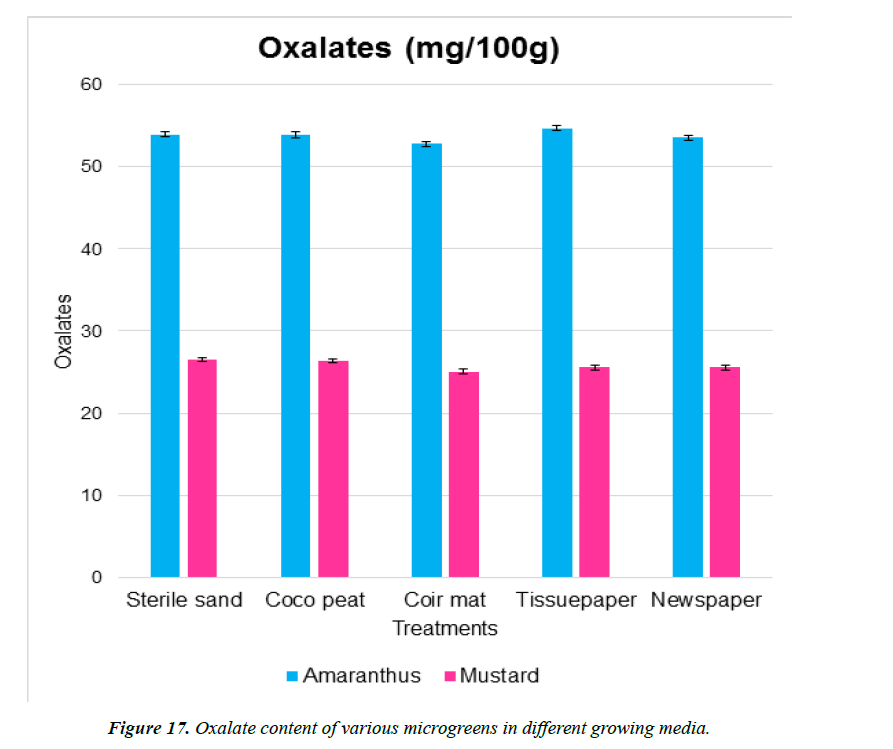Brief Report - Journal of Food Science and Nutrition (2022) Volume 5, Issue 2
Influence of seed treatment and growing media on six species of microgreens.
Arya KS*, Kutty MS
Department of Agriculture, Kerala Agricultural University, Thrissur, Kerala 680 656, India
- *Corresponding Author:
- Arya KS
Department of Agriculture
Kerala Agricultural University
Thrissur
Kerala 680 656
India
Tel: 9526427650
E-mail: aryaksarjunks@gmail.com
Received: 29-Dec-2021, Manuscript No. AAJFSN-22-50855; Editor assigned: 31-Dec-2021, PreQC No. AAJFSN-22-50855(PQ); Reviewed: 21-Jan-2022, QC No. AAJFSN-22-50855; Revised: 25-Jan-2022, Manuscript No. AAJFSN-22-50855(R);Published: 02-Feb-2022, DOI:10.35841/aajfsn-5.2.106
Citation: Arya KS, Kutty MS. Influence of seed treatment and growing media on six species of microgreens. J Food Sci Nutr. 2022;5(2):106
Abstract
Microgreen cultivation is a novel idea to develop highly nutritious tender greens from seeds of vegetables or herbs with cotyledonary leaves and a pair of true leaves in a small area with limited supply of light and temperature. The study was conducted with the aim to standardize seed treatment and growing media for microgreen production. The observation recorded in standardization seed treatment experiment were germination percentage, seedling vigour, yield and microscopic observation for fungal growth. All the observations were noted to be on par while treating the seeds with chemicals compared to control. The observations noted in growing media standardization experiment were yield, seedling height, nutritional value of microgreens and microscopic observations on fungal growth. The yield was significantly higher for the microgreens grown in cocopeat media. Seedling height was noted to be on par when grown in different growing media except for ragi and mustard microgreens. Analysis on nutritional value of microgreens reveals that iron content was reported to be maximum in amaranthus microgreens, calcium content was recorded to be highest in ragi microgreens, beta carotene was noticed to be maximum in mustard microgreens, vitamin C was maximum in amaranthus micogreens, crude protein was recorded to be highest in wheat reported maximum fibre content and chlorophyll content was highest in green gram microgreens. Nitrates and oxalates were estimated only for amaranthus and mustard microgreens, it was also not influenced by the different growing media but among the species amaranthus reported highest oxalate content. No fungal contamination was recorded in freshly harvested microgreens. So, cocopeat was selected as the best growing media for microgreen production.
Keywords
Microgreen cultivation, Seed treatment, Fungal growth.
Introduction
Microgreens are tender immature greens produced from the seeds of vegetables and herbs, having two fully developed cotyledon leaves with or without the emergence of a rudimentary pair of first true leaves [1]. They are also a new class of edible vegetables with lots of potential in term of nutritional ability to cure various deficiencies [2]. Microgreens are small in size, can provide surprisingly intense flavors, vivid colors, and crisp textures and it can be served as an edible garnish or a new salad ingredient. Commonly grown microgreens include amaranth, basil, beet, cabbage, celery, chervil, chinese kale, cilantro, fennel, mustard, parsley, radish, swiss chard etc. They are rich source of vitamin C, vitamin E, vitamin K and beta- carotene and also minerals like Ca, Mg, Fe, Mn, Se and Mo [2]. The advantages of growing microgreens are: it has a quick production cycle (two to three weeks), occupies very little space and need only less production cost [3]. The microgreen production is currently gaining interest due to the potential of it to enhance economic, food and nutritional security to farmers.
Materials and Methods
The present study was carried out in carried out in the Department of Vegetable Science, College of Agriculture, Vellanikkara. Six species of crops were used for the study viz, wheat, ragi, green gram, horse gram, amaranthus and mustard. The study was conducted in CRD design and as two experiments. First experiment was standardization of seed treatment for microgreens conducted with three replications. The treatments for this experiment were seed treatment with two chemicals viz, T1- hydrogen peroxide @ 0.5%, T2- hydrogen peroxide @ 1%, T3- hydrogen peroxide @2%, T4- vinegar @ 2%, T5- vinegar @ 5%, T6- vinegar @ 7% and control. The seeds were soaked for 10 minutes in chemicals followed by washing in sterile water to remove excess chemicals. Then the seeds were soaked in sterile water for 12 hours and after that, water is drained out and seeds were shade dried. The seeds were then broadcasted in the tray filled with growing media. The observations on germination percentage, seedling vigour, yield and microscopic observation for fungal growth were recorded.
Second experiment was conducted to standardize the growing media for microgreen production and it was carried out with five replications. Treatments used in this experiment were T1- sterile sand, T2- cocopeat, T3- coir mat, T4- tissue paper and T5- newspaper. The seeds of six crops were soaked in sterile water for 12 hours and are shade dried. The shade dried seeds were then broadcasted in trays filled with different growing media. Irrigation was provided thrice or four times a day with sterile water. The observations recorded were yield, seedling height, nutritional value of microgreens and microscopic observations on fungal growth.
Results and Discussion
The result obtained from first experiment reveals that seed treatment using two chemicals; hydrogen peroxide and vinegar at different concentrations were not exhibiting any influence on seed germination, seedling vigour and yield of microgreens. The microscopic observation on freshly harvested microgreens revealed that fungal contamination is absent in the harvested produce. The seed treatments were not showing any negative effects on seed germination, seedling vigour and yield of microgreens compared the control. This indicates that the seed lot used for the study was of good quality and free from any contamination. Thus we can conclude that if the seed lot used for microgreen production is free from contamination, then there is no requirement of seed treatment it is recommended only if the seeds are of poor quality (Figure 1-5).
The second experiment the observations on yield showed that it was highest when grown in cocopeat media than on other four media. The cocopeat media has the maximum water holding capacity, provide good aeration and maintain wettability for long period which promotes the healthy root growth of microgreens thus the shoot growth was maximum in this media. Among the six crops, green gram recorded the highest fresh (1.03 to 1.49 kg/m2) and dry weight (0.230 to 0.333 kg/m2) and the least yield was recorded for amaranthus microgreens (fresh weight- 0.28 to 0.48 kg/m2 and dry weight- 0.027 to 0.046 kg/m2). The seedling height recorded when grown in five growing media was observed to be same except for ragi and mustard microgreens where it was maximum for cocopeat raised microgreens and least was noted for newspaper grown one (Figure 6-8).
The nutrional value of microgreens assessed reveals that it was not influenced by different growing media; it varied only with different species used for microgreen production. The iron content was reported to be maximum in amaranthus microgreens (1.43 to 1.7 mg/100g), calcium content was recorded to be highest in ragi microgreens (279.13 to 287.06 mg/100g), beta carotene was noticed to be maximum in mustard microgreens (2.63 to 3.06 mg/100 g), vitamin C was maximum in amaranthus micogreens (35.2 to 42.25 mg/100g), crude protein was recorded to be highest in (1.5 to 2 g/100g), wheat reported maximum fibre content (21.8 to 22.4%) and chlorophyll content was highest in green gram microgreens (1.31 to 1.4 mg/g). Nitrates and oxalates were estimated only for amaranthus and mustard microgreens, it was also not influenced by the different growing media but among the species amaranthus reported highest oxalate content (76.26 to 79.46 mg/100g) and nitrate content (51.13 to 54.23 mg/100g). The freshly harvested microgreens were not exhibiting any fungal contamination [4,5] (Figure 9-17).
Conclusion
It can be concluded that if the seeds used for microgreen production are of good quality, then there is no requirement of seed treatment. It can be recommended only if the seeds used are of poor quality. In selection of growing media, cocopeat was identified as the best growing media for microgreen production as it encourages the fast and good development of microgreens and provide desirable qualities like good water holding capacity and aeration which supports the root growth. The coco peat is cheapest, easily available and almost similar to peat which the common is growing medium used for microgreen production so it is best suited for microgreen production.
References
- Xiao Z, Lester GE, Luo Y, et al. Assessment of vitamin and carotenoid concentrations of emerging food products: Edible microgreens. J Agric Food Chem. 2012;60(31):7644-51.
- Pinto E, Almeida AA, Aguiar AA, et al. Comparison between mineral profile and nitrate contents of microgreens and mature lettuce. J Food Comp Anal. 2015;37:38-43.
- Kumar S, Jasmin LB, Saravaiya. Microgreens: A new beginning towards nutrition and livelihood in urban-peri- urban and rural continuum. In: Technologies and Sustainability of Protected Cultivation for Hi-Valued Vegetable Crops. Navsari Agricultural University, Gujarat, India. 2018:246-61.
- Awang Y, Shaharom AS, Mohamad RB, et al. Chemical and physical characteristics of cocopeat-based media mixtures and their effects on the growth and development of Celosia cristata. Am J Agric Biol Sci. 2009;4(1):63-71.
- Landis TD, Jacobs DF, Wilkinson KM, et al. Growing media. The container tree nursery manual, 2, 1990;41-85.
Indexed at, Google Scholar,, Cross Ref,
Indexed at, Google Scholar,, Cross Ref,
Indexed at, Google Scholar,, Cross Ref,
